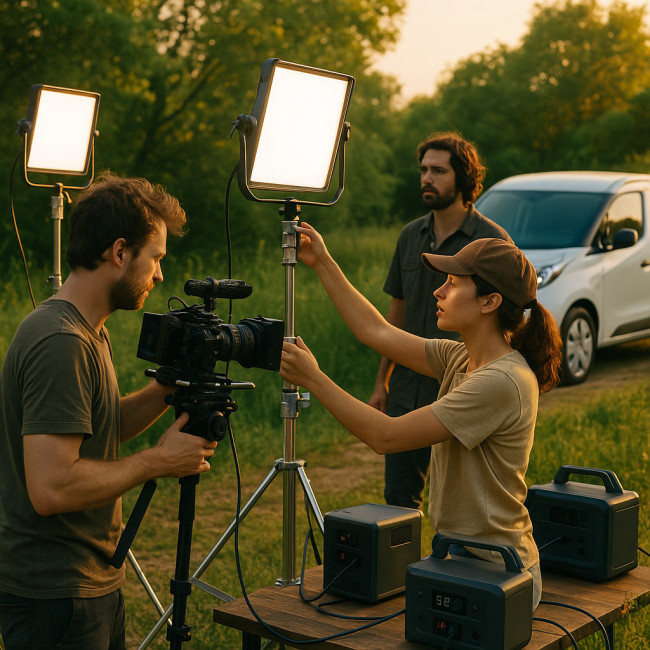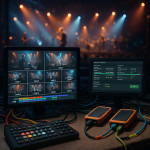Eco-friendly filming: sustainable gear choices that cut costs and impress brands
Switching to greener gear is no longer a fringe choice for videographers. It trims budgets, attracts conscious brands and helps you future-proof your business. This guide walks you through the smartest swaps—from lighting and power to camera bodies—so you can shoot sustainably without sacrificing creative punch.
Why sustainable filming gear is a win-win
Brands demand visible effort
Global advertisers now tie procurement targets to measurable carbon reductions. When you roll up to set with LED panels and battery stations, you signal that you understand their ESG metrics and can help them meet them. It turns your service into a brand-safe choice instead of just a technical hire.
Lower operating costs
Eco-friendly tools draw less power, weigh less and require fewer consumables. You save on rental trucks, generator fuel and even overtime because smaller rigs set up faster. Those savings compound across multiple gigs and free margin you can reinvest in marketing—like improving your local SEO pages to capture more leads.
Future legislation readiness
Cities from London to Los Angeles are tightening emissions rules for commercial shoots. By adopting low-impact gear today, you skip the last-minute scramble for compliance tomorrow and keep your booking calendar stable.
The big-ticket swaps that shrink your footprint

From the outside, replacing a 30-kilogram HMI with a featherweight LED may look like a simple technical upgrade, yet it reshapes every downstream element of a shoot's logistics chain. Smaller lamps mean lighter grip, which in turn allows your gaffer to arrive in a passenger car instead of a lorry. Once transport requirements drop below 3.5 tonnes, you skip congestion fees in most European cities, remove the need for a specialist driver and gain access to loading docks that were previously off-limits. Multiply that micro-shift across cameras, monitors, batteries and even storage cases and you unlock an exponential reduction in scope-three emissions as well as hard costs on parking, fuel and overtime. Clients rarely calculate these hidden savings, so highlighting them in pitches turns a technical footnote into a persuasive business argument.
Lighting: LEDs beat legacy fixtures
Replace tungsten and HMI units with high-CRI LEDs. A 100 W LED panel delivers the same exposure as a 1 kW tungsten fresnel yet draws 90 % less electricity. Less heat also means lighter air-con loads on indoor sets.
Power: portable batteries and solar generators
Modern V-Mount and block batteries paired with foldable solar mats eliminate the roar and fumes of diesel. They fit inside a hatchback instead of a box truck, cutting rental and parking fees. Remember to pack a slim mains charger as a fail-safe—covered in our article on shoot-day risk management.
Cameras: mirrorless bodies & efficient codecs
Full-frame mirrorless cameras such as the Sony FX3 or Canon R5 C boast dual native ISO, letting you light with softer, lower-wattage sources. Choosing an intra-frame codec like ProRes LT reduces processing strain later, trimming workstation energy use.
Grip & accessories: aluminium, not steel
Light-weight aluminium stands, recycled-rubber sandbags and reusable cable ties shave kilograms off every load-out. They also require fewer crew hands, which can offset your day rates and win small brand clients evaluating bids on tight budgets.
Cost and emission comparison
| Gear choice | Average power draw per hour | CO₂e per 100 h (kg) | Energy cost per 100 h (USD) |
|---|---|---|---|
| LED panel 100 W | 0.1 kW | 4.0 | $1.20 |
| Fluorescent 200 W | 0.2 kW | 8.0 | $2.40 |
| Plasma 400 W | 0.4 kW | 16.0 | $4.80 |
| HMI 575 W | 0.575 kW | 23.0 | $6.90 |
| Tungsten 1 kW | 1.0 kW | 40.0 | $12.00 |
Quick self-check: How sustainable is your current kit?
Workflow tweaks that amplify the benefits
Plan for repurposing
Design shoot lists with multi-platform reuse in mind. A single location move has a carbon cost, so maximise each one with B-roll that feeds future edits. Our footage repurposing roadmap shows step-by-step tagging and storage tactics.
Bundle services with trusted vendors
Rather than hiring separate sound, lighting and streaming crews—each with their own vans—team up with partner providers. See how to structure equitable packages in our AV alliance guide.
Showcase your green credentials online
List specific watt-savings and waste-reduction stats on your Artfolio profile for videographers. Recruiters browsing the videographer directory often filter by sustainability terms—being explicit boosts shortlist rates.
Real-world mini-case study
A boutique fashion label needed a two-day lookbook video. By swapping three 1 kW tungsten fresnels for 100 W LED panels and running all monitors off a 2 kWh lithium power station, the crew:
- Cut generator hire fees by €180
- Reduced set-up time by 45 minutes each day
- Kept studio temperature down, saving on air-con
- Won a follow-up brand film because the client used the results in their sustainability report
FAQ
- Do eco-friendly lights match the color quality of tungsten?
- Yes. Modern LED panels hit CRI and TLCI scores above 95, delivering accurate skin tones and consistent flicker-free output.
- Are battery power stations safe for indoor use?
- Lithium iron phosphate models include advanced BMS circuits, emit no fumes and are certified for enclosed spaces, unlike petrol generators.
- Will switching gear void my insurance?
- No. Most policies cover equipment by value, not by type. Just update your inventory list before the next renewal.
Take action today
Audit your kit list, calculate potential savings with the table above and plan your next purchase around low-draw lighting or modular battery systems. Your budget, clients and the planet will thank you. Ready to pitch a greener production? Reach out now and turn sustainability into your competitive edge.











